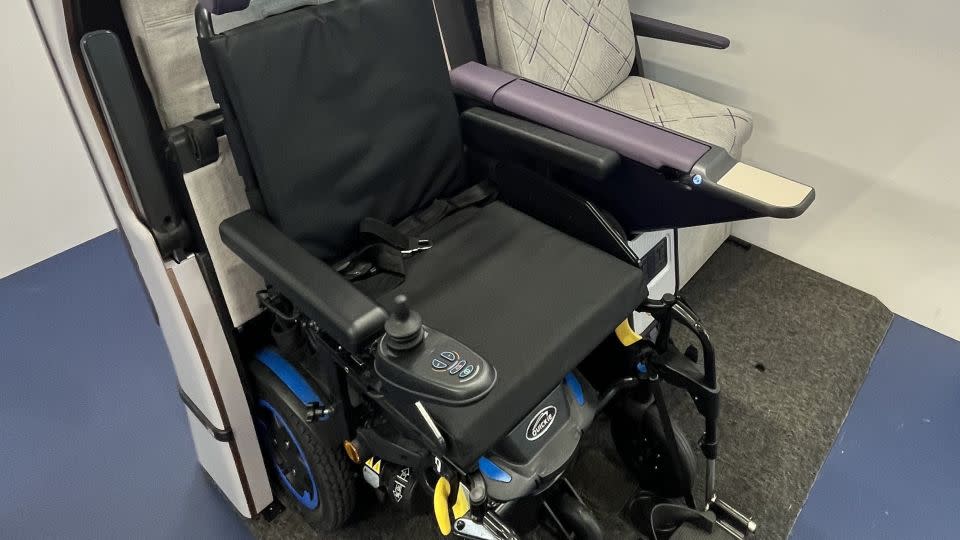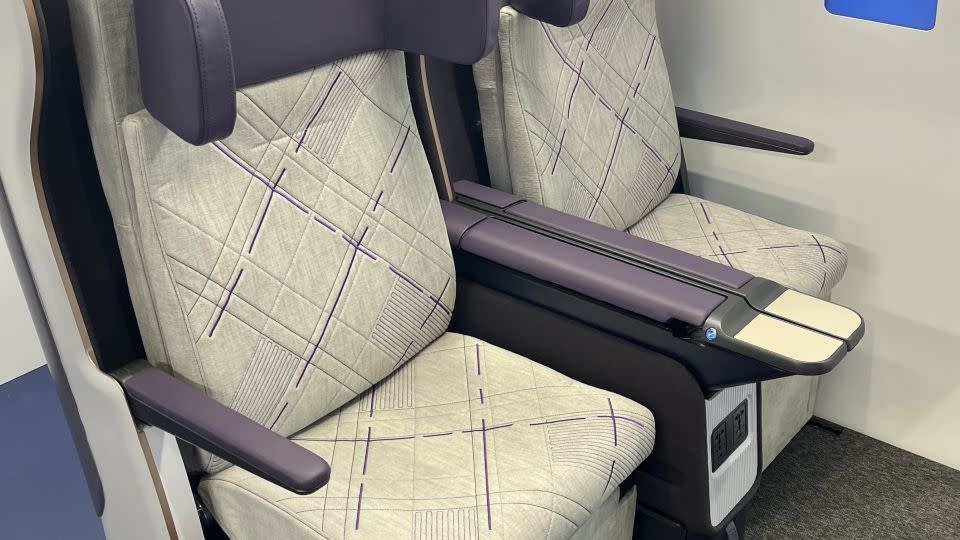‘Unbelievably excited’ - wheelchair users react to new Delta airplane seat design
A new airplane seat concept that allows wheelchair users to stay in their own chair throughout a flight was revealed this week by a subsidiary of US airline Delta, a move welcomed as a “huge step” by potential customers.
“Unbelievably excited,” is how power wheelchair user and avid traveler Cory Lee described his reaction after a working prototype of the design was demonstrated by Delta Flight Products (DFP) at the Aircraft Interiors Expo (AIX) in Hamburg, Germany, a symposium spotlighting airplane cabin innovations.
DFP’s concept seamlessly converts to and from a traditional airplane seat. The built-in seat folds up to allow a wheelchair to be docked into place. The seat would be installed into pre-existing aircraft seat track systems, so would not involve any structural change to the airplane.
When the seat’s in wheelchair mode, flyers are still able to use the tray table – the center console that houses the tray table rises to the appropriate height when the seat conversion takes place.
Rick Salanitri, DFP president, told CNN Travel at AIX that the goal is to make the conversion seamless.
Though still only a prototype, the design is already generating significant buzz among wheelchair users who could be among potential customers. It’s hoped that the concept could enter commercial use within 18 months if it passes testing and is adopted by airlines.
“For decades, people with disabilities have been fighting for more accessible air travel, and this feels like a huge step (or a giant roll) toward real inclusivity,” Lee told CNN Travel via email.
Lee’s visited 43 countries and counting, documenting his adventures on his blog. He loves exploring the world, but said at present air travel is “tremendously difficult” for him.
As airlines can’t typically accommodate powered chairs, Lee usually has to use a non-electric, airport-owned one, which he can’t control himself. This, he said, leads to a “scary” loss of independence.
This discomfort continues when he boards a plane and must be lifted by staff into an aisle wheelchair, and then again onto an airplane seat.
“During those transfers, I’ve nearly been dropped on several occasions,” said Lee.
Once on board, Lee spends the whole journey concerned that his personal wheelchair may be damaged during flight (“It has been damaged so badly that I couldn’t even drive it out of the airport on two different occasions,” he explained.)
Lee’s experiences are not unique. Air travel is infamously inaccessible, with disability activists vocal about the dehumanizing and dangerous air experience for wheelchair users.
New design

To produce this new seat design, DFP partnered with UK-based consortium Air4All. Air4All comprises aviation design company PriestmanGoode, advocacy group Flying Disabled, aerospace company SWS Certification and wheelchair design company Sunrise Medical.
Flying Disabled’s Christopher Wood kickstarted the consortium a few years ago. His two adult children are wheelchair users who love to travel, and Wood’s seen firsthand the issues they encounter on airplanes.
“I did research to try and create a solution,” Wood tells CNN Travel at AIX. First, he looked into working with nonprofits. Eventually he concluded he needed to go directly to an aviation company. He approached Priestman Goode and Air4All was formed.
“I found like minded people,” said Wood.
Somewhere along the line, DFP – described by Salanitri as “a product development company inside of the airline” – and Priestman Goode started talking about the concept.
“We thought the idea had some merit,” said Salanitri. DFP bookmarked the idea, and then revisited it when they were approached by Delta Air Lines customer service team to see if they could develop “some sort of carrier that they could put customer wheelchairs in.”
That was an “aha” moment, said Salanitri.
‘Well, we came across this other idea here,’” he recalled saying.
That was around 18 months ago, and the product’s been in development ever since.
DFP said it brought in a disability focus group to weigh in every step of the way. One of the key pieces of feedback, said product innovation manager Tyler Anderson-Lennert, was the height of the center console, which now elevates when the seat is in wheelchair mode.
“This has been done with some serious backing from the community to give their feedback,” added Flying Disabled’s Wood, who said it was important that this wasn’t an airline “lecturing to the community,” but rather a collaborative, instructive process.
Real world implication

At AIX, the DFP team has spent the past few days demonstrating their seat to aviation industry insiders. Wood said the reaction has been “genuine enthusiasm.”
What’s perhaps most striking at first look is that the seat maintains the same aesthetic whether it’s in its traditional airplane seat mode, or in its wheelchair conversion. The team wanted to make it “stylish” and they’ve succeeded.
The conversion process, as demonstrated to CNN Travel by DFP engineers, is also incredibly swift and smooth, taking around 90 seconds.
The team is now working on the next steps to make the concept a reality.
“We’re going through the testing and development and certification for the chair that is going to make that chair viable to go on an aircraft – we’re projecting within 18 months,” said Anderson-Lennert.
Salanitiri said DFP has also started informal discussions with the US Federal Aviation Administration, as well as the UK Civil Aviation Authority.
Although DFP is a subsidiary of Delta, Salanitiri said he cannot confirm whether or not Delta will be the first airline to implement the seat design.
The ultimate goal, added Wood, is getting the seat on every airline.
The team hopes implementing the concept would be straightforward for airlines to install, though they currently don’t know what costs could look like.
“Here’s the perfect world,” said Salanitri. “I pick up the front row of all domestic airplane seats and I drop these in, no other changes, I’d have to integrate a little bit of IFE [in-flight entertainment] into it, there’ll be some regulatory certification that goes into it, but it’s a very low time, low cost modification in the perfect world.”
In terms of ticket fare, Salanitri said the wheelchair version of the seat will likely be within “the price point of a standard domestic first class seat.”
Key step
Flying Disabled’s Wood said he’s thrilled his team’s found a potential way to improve what he calls the biggest barrier to accessible air travel, but he acknowledges that there are other unresolved issues and more to be done.
Wheelchair traveler Lee agrees, pinpointing aircraft restrooms as the next problem that should be addressed.
“Currently, they are so small that it’s impossible for a caregiver and I to go in for me to use the restroom,” he said. “Currently, I have to severely limit my food and liquid intake in the days leading up to a flight, so that I won’t need to use a restroom onboard the plane.”
Still, Lee said he’s thrilled that “an airline has finally acknowledged that there needs to be a wheelchair spot on planes, and is trying to make it happen.” He adds that he’s “immensely looking forward” to a time when he can stay in his own wheelchair on a flight.”
“On a daily basis, I receive messages from other wheelchair users saying that they want to travel, but they’re terrified that their wheelchair will get damaged, so they choose to just do road trips,” Lee said. “In 2023, they shouldn’t be saying that. Until air travel is inclusive for everyone, including wheelchair users, it isn’t inclusive at all.
For more CNN news and newsletters create an account at CNN.com

